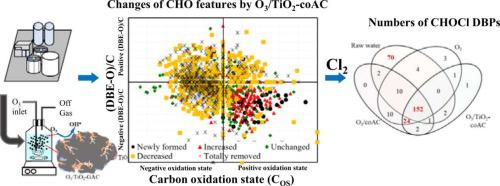Journal of Environmental Chemical Engineering ( IF 7.4 ) Pub Date : 2022-01-19 , DOI: 10.1016/j.jece.2022.107215 Nutdanai Dabuth 1 , Sattawat Thuangchon 2 , Thirawit Prasert 1 , Vitharuch Yuthawong 3 , Phanwatt Phungsai 1, 4

|
This study investigates the applicability of coconut- and coal-based activated carbon (ccAC and coAC) and eucalyptus biochar coated by titanium dioxide (TiO2-ccAC, TiO2-coAC, and TiO2-biochar, respectively) as a catalyst of catalytic ozonation. Molecular dissolved organic matter (DOM) removal and minimization of unknown disinfection by-products (DBPs) formation were investigated by unknown screening analysis with Orbitrap mass spectrometry. By ozonation with the catalyst, coAC could achieve the highest DOC removal of 1.5 mgC L−1 followed by ccAC at 1.2 mgC L−1 while other catalytic ozonation and O3 alone were similar with 1.0 mgC L−1 removal. The oxidation treatments removed high molecular weight molecules and formed oxidation by-products (OBPs) with low molecular weight highly oxidized (high carbon oxidation state (Cos), and saturated (negative (DBE-O)/C) character). Coating catalysts with TiO2 enhance removal of molecules with more oxidized and saturated compounds and formed a fewer number of OBPs. Catalytic ozonation before chlorination removed and produced organic precursors as increasing of trihalomethanes formation potential (THM-FP) and decreasing of intermediate chlorinated DBPs were observed. Almost half of CHO and CHOCl DBPs generated in the samples pre-oxidized by O3 alone, O3/coAC, or O3/TiO2-coAC were similar, and some of the unique DBPs were also found by each treatment. Applications of catalytic ozonation in water treatment still need post treatments to ensure removals of OBP precursors before disinfection.
中文翻译:

Orbitrap质谱研究TiO2活性炭和生物炭催化臭氧化对溶解有机物去除和消毒副产物形成的影响
本研究探讨了椰子基和煤基活性炭(ccAC 和 coAC)和涂有二氧化钛的桉树生物炭(分别为 TiO 2 -ccAC、TiO 2 -coAC 和 TiO 2 -生物炭)作为催化催化剂的适用性。臭氧化。通过使用 Orbitrap 质谱仪进行未知筛选分析,研究了分子溶解有机物 (DOM) 的去除和未知消毒副产物 (DBP) 形成的最小化。通过用催化剂进行臭氧化,coAC 可以达到 1.5 mgC L -1的最高 DOC 去除率,其次是 1.2 mgC L -1的 ccAC,而其他催化臭氧化和单独的 O 3与 1.0 mgC L -1相似移动。氧化处理去除了高分子量分子并形成了具有低分子量高度氧化(高碳氧化态(C os)和饱和(负(DBE-O)/C)特征)的氧化副产物(OBP)。具有 TiO 2的涂层催化剂增强了具有更多氧化和饱和化合物的分子的去除,并形成了更少数量的 OBP。观察到氯化前的催化臭氧化去除并产生有机前体,因为观察到三卤甲烷形成潜力(THM-FP)的增加和中间氯化DBP的减少。仅由 O 3、O 3 /coAC 或 O 3预氧化的样品中产生的 CHO 和 CHOCl DBP 几乎有一半/TiO2-coAC 相似,并且每种处理也发现了一些独特的 DBP。催化臭氧在水处理中的应用仍需要后处理,以确保在消毒前去除 OBP 前体。









































 京公网安备 11010802027423号
京公网安备 11010802027423号